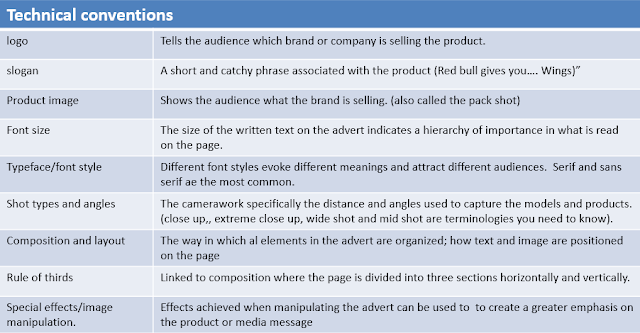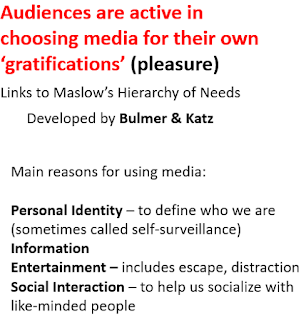Advertising and Marketing
Media language : How the media through
their forms, codes, conventions and techniques communicate meaning(s).
Representations :
How the media portray events issues,
individuals and social groups

Social context refers to the settings surrounding individuals, including the culture they live in and groups that they interact with. Social context influences customs, traditions and other socially acceptable standards. Cultural context is about the society the characters live in and at how their culture can affect their behaviour and their opportunities.
Advertising: Is the process of making a product or service known to the market and the target audience.
Marketing: is
the process of preparing a product for the marketplace. Advertising is one of several components used
in the marketing strategy.
Lucozade
CAGED- class, age, gender, ethnicity, disability
lucozade advert
The use of blue and yellow is effective due to the pair complimenting eachother on a colour wheel, and therefore being more appealing when put together.
Created in 1927 as Glucozade-meant to give energy to the sick
Renamed Lucozade in 1929
Rebranded as a sports drink in 1983 rather than health
Lots of sponsership deals with various sports
TV campaign 'Last man standing' on ITV January 2013 for the FA
New scientific claim- Lucozade Sport hydrates and fuels you better than water
Soft Drinks Adverts-
An able bodied man would have a preferred/ dominant reaction to the ad due to them being the main target audience, and could presuambly make good use out of the drinks self aclaimed benefits. The colour palette is heavily aimed towards males, and also shows a famous male football player endorsing the product, which would impress the able bodied man and encourage him to buy the product. He would also be suseptible to believe the false scientific claims, and therefore be even further impressed and feel that using the drink during his daily life is essential. This man may also see Bale on the poster and want to try and be more like him, and so if Bale supports using Lucozade during excercise, the man will feel incined to do the same.
A woman would have a negotiated response to the ad, accepting its message but seeing no particular reason why they should buy the product themselves. The advert is heavily masculine, which gives it an unapproachable feel for the woman who may stumble upon it. Despite this, they may find the scientific claims interesting, and therefore not completely reject the ad's message due to the potential benefits at hand. One thing that could potentially attract them towards the advert would be the appeal of Bale and how nice they make him look, with use of special effects making his eyes look more blue, which would attract more females.
A man with a physical disability would feel oppositional towards the advert, and therefore completely reject the message whilst also possibly feeling offended by the lack of appeal towards him. The ad focuses on the sporting benefits of Lucozade, and so a man with a disability would not be able to participate in such activities, and could therefore feel left out and have the ad remind him of how much he misses out on despite not having a choice in the matter. The advert is entirely focused on the sporting benefits, leaving the disabled man with nothing to benefit from by purchasing the product.
Old Spice
The stereotypes in this modern advert are that women prefer men that smell very masculine and shy away from more feminine fragrances due to needing a big strong man to marry. The stereotype of men being that they are quite full of themselves, which is demonstrated by Mustafa saying "now back at me", displaying a very confident demeanour. Men can also be stereotyped to be strong which is demonstarted through the man not wearing a shirt and having a very muscle covered body- showing that not only does he have a good tone and physique, but he has a lot of strength, which women are stereotyped to love. Not only does the actor ride a horse, he also holds diamonds which makes it evident that he is wealthy. The aim of the advert is to show an architectual figure, who does not conform to the stereotypes that men do not help around the house, showing that men can in fact be independant despite popular belief. The actor follows the sterotype of race by being exotic and humerous, with bland jokes and constantly being in the beach environment whilst on screen. Finally, he follows the black stereotypes of being a comedian, sporty with a previous athletic career which would explain his body and being promiscous.
There is a woman as the dominant role of the advert due to women being in charge of getting men christmas presents, due to them working hard and needing a reward. The ad is still centered around men despite showing mainly a woman, by spreading the message that women whould get their husbands old spice for christmas. There is also the stereotype that women are weak and need a man to take care of them, which is shown by the actor looking sadly out to sea alone, making it clear that she needs him. The job of the woman in this advert is to be the beauty appeal and the job of the man is to seem strong by returning home after being at sea, making him appear brave.
modern Old Spice ad conventions
Celebrity endorsement-
Humour- Isaiah Mustafa is dry, Terry Cruise is funny, energetic and chaotic
Escape- on an island in the Bahamas
Unfinished claim- 'not fact checked' adds to the humour

Colour palette- bright and eye catching
SFX- photoshop and editiing software used to create scenery and an environment that fits the product
Location and setting- appears to be on a beach despite most likely being green screen form a studio
Costume and makeup- models covered in sand to blend in with the beach
Register/ mode of address- informal to feel more down to earth
Anchorage- the main image is the first thing you see, in order to make the ad stand out
Intersexuality- reference to the actors fame to appeal to a broader audience
SFX- photoshop and editiing software used to create scenery and an environment that fits the product
Location and setting- appears to be on a beach despite most likely being green screen form a studio
Costume and makeup- models covered in sand to blend in with the beach
Register/ mode of address- informal to feel more down to earth
Anchorage- the main image is the first thing you see, in order to make the ad stand out
Intersexuality- reference to the actors fame to appeal to a broader audience

Logo- old spice
Product Image- two different sizes of the product to make people aware they have options
Font size- the logo is larger than the sans-serif font to stand out and look nicer
Shot types- wide angle to make the beach seem larger than it actually is
Composition & rule of thirds- product image in the last third, main image in the first-always something nice to look at
The female gaze is a feminist film theoretical term representing the gaze of the female viewer. It is a response to feminist film theorist Laura Mulvey's term, "the male gaze", which represents not only the gaze of a heterosexual male viewer but also the gaze of the male character and the male creator of the film.
Entertainment- the use of escape links to the location and setting of the ad which is set in the Bahamas.
Postmodernism is a late 20th-century
style and concept in the arts, architecture, and criticism, which represents a
departure from modernism and is characterized by the self-conscious use of
earlier styles and conventions, a mixing of different artistic styles and
media, and a general distrust of theories.
Viewpoints and ideologies
Old Spice Smell like a man campaign can
be seen to reinforce patriarchal ideology.
The use of Isaiah Mustafa to promote the
product and slogan will reinforce the ideological dominance of men within
society.
The advert constructs representations
that communicate to men and women. The idea that the product if purchased will
lead to
self fulfilment and men become better men.
The advert draws on common patriarchal
stereotypes such as:
•- sexually attractive- smirk
•- male domainance
•- power- body language + facial expression - smirking and confident
It uses visual codes in media language to
appeal to the target audience.
The advert also reinforces ideological
assumptions about :
-Consumerism
-Individualism
The representation of masculinity also (arguably) reinforces ethnic stereotypes of the hypersexualised black male within the media.
Shelter
Brand new analysis from Shelter reveals that 320,000 people are recorded as homeless. In the last year, the overall number increased by 13,000 people. This means one in every 200 people in Britain are homeless and sleeping on the streets or stuck in temporary accommodation. Since 2010, there has been a 165% increase in homelessness, meaning that 1 in every 201 people in the UK do not have a home. Half of these people are in London
Viewpoints and ideologies- the 'a home for everyone' campaign communicates several ideological values, with some contrasting one another. The advert reinforces a viewpoint that social inequality is injust and that those in positions of social power/ wealth have a duty to help homeless. In the context of this viewpoint, the ad supports a social, liberal view with the idea that we have a duty to help one another. The ad also reinforces values of individualism by suggesting that everyone has the right to a better life. To some extent, this is reinforced through the ideology of consumerism by using the advert form, which relies on the consumption of messages and values to create empathy and persuade an audience to donate.
Audience response and interpretation- the preferred reading could be that homelessness can happen to anyone for multiple reasons. In addition, another meaning suggests that we should feel empathy & respinsibility to help those less fortunate than ourselves. The audiences reaction will depend on their own experiences and demographic; In particular, it depends on their views of charity.
A middle-class woman would respond to the advert with a dominant response to what Shelter would prefer. This is because she would find the ad most relatable, with two other women on the advert making her feel more concerned that it could happen to her. Also, the middle-class woman would relate to them characters of the advert due to possibly having her own financial difficulties as a result of being middle class, and therefore feeling more empathy.
A middle-class woman would respond to the advert with a dominant response to what Shelter would prefer. This is because she would find the ad most relatable, with two other women on the advert making her feel more concerned that it could happen to her. Also, the middle-class woman would relate to them characters of the advert due to possibly having her own financial difficulties as a result of being middle class, and therefore feeling more empathy.























